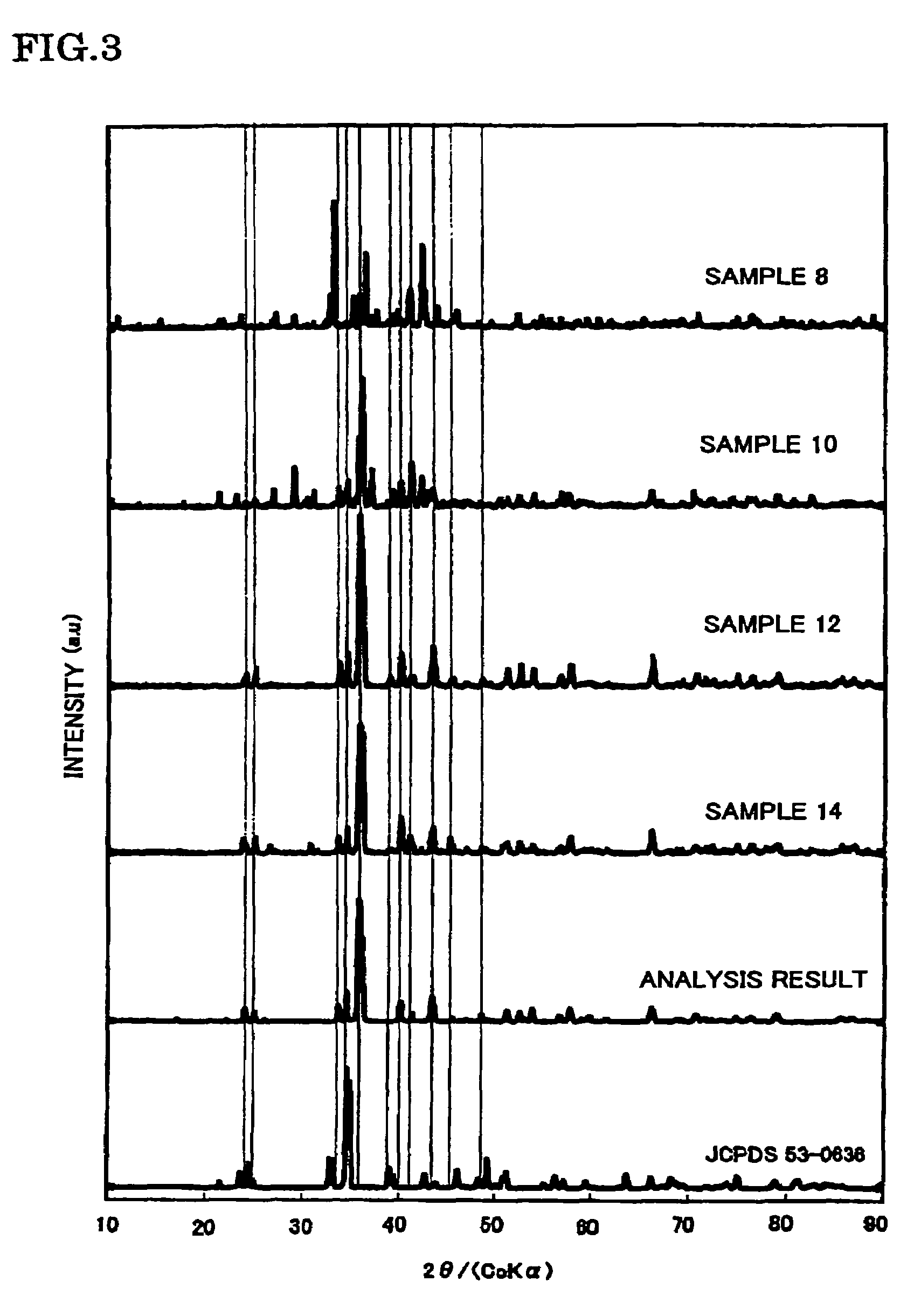Phosphor and manufacturing method of the same, and light emitting device using the phosphor
a technology of phosphor and manufacturing method, which is applied in the direction of discharge tube/lamp details, discharge tube luminescent composition, discharge tube luminescent screen, etc., can solve the problems of short life span, loss of balance of blue color and yellow color emission intensity, and deterioration of color rendering properties which are essential factors of illumination, etc., to achieve excellent emission efficiency, emission intensity and luminance, and easy pulverization
- Summary
- Abstract
- Description
- Claims
- Application Information
AI Technical Summary
Benefits of technology
Problems solved by technology
Method used
Image
Examples
example 1
[0103]In an example 1, sample 1 to sample 6 were manufactured by procedures as will be described below. In the samples 1 to 6, SrSi7N10:Eu and SrSi7N10:Eu with some replacement of oxygen in nitrogen-site were prepared by firing at 1800° C.
[0104]First, the manufacturing method of SrSi7N10:Eu of the sample 1 will be explained. The commercially available Sr3N2(2N), Si3N4(3N), and Eu2O3(3N) were prepared as the raw materials, and each raw material was weighed to obtain 0.970 / 3 mol of Sr3N2, 7 / 3 mol of Si3N4, and 0.030 / 2 mol of Eu2O3, so that the molar ratio of each element becomes Sr:Si:Eu=0.970:7:0.030, and mixed by using the mortar in the atmospheric air. The raw materials thus mixed were put in the BN crucible, and after vacuously exhausting the inside of the furnace once, temperature was increased at 15° C. / min up to 1800° C. with the pressure in the furnace set at 0.05 MPa in the nitrogen atmosphere (flow state at 20.0 L / min), and the raw materials were retained / fired at 1800° C. f...
example 2
[0113]In the example 2, samples 7 to 14 were manufactured by the following procedure.
[0114]The samples 7 to 14 were manufactured in such a manner that the molar ratio of Sr, Al, and O was fixed to 1, 1, 1, respectively and the b / m ratio thereof was changed, and the raw materials were then fired at 1800° C., in the phosphor expressed by the composition formula SrAlSibONn:Eu (Eu / (Sr+Eu)=0.030, n=(2 / 3)m+a+(4 / 3)b−(2 / 3)o, m=1, a=1, and o=1) in which Al was further added to the constituent elements Sr, Si, O and N of the matrix body of the example 1, as the constituent element of the matrix body.
[0115]In addition, in the manufacture of each sample, the phosphor sample was manufactured in the same way as the sample 1 of the example 1, excepting that the commercially available SrCO3(3N), AlN(3N), Si3N4(3N), and Eu2O3(3N) were prepared as the raw materials, and the mixing ratio of each raw material was adjusted to become a predetermined b / m ratio. Specifically, the b / m ratio is adjusted to b...
example 3
[0128]Samples 15 to 23 were manufactured in such a manner that the molar ratio of Sr, Al, and Si was fixed to 1, 1, 7, respectively and an o / m ratio was changed, and the raw materials were then fired at 1800° C., and the emission intensity was measured, in the phosphor expressed by the composition formula SrAlSi7.0OoNn:Eu(Eu / (Sr+Eu)=0.030, n=(2 / 3)m+a+(4 / 3)b−(2 / 3)o, m=1, a=1, and b=7). In the manufacture of each sample, the commercially available Sr3N2(2N), SrCO3(3N), Al2O3(3N), AlN(3N), Si3N4(3N), and Eu2O3(3N) were prepared as the raw materials, and in the same way as the sample 1 of the example 1, the phosphor sample was manufactured excepting that the mixing ratio of each raw material was adjusted to a predetermined o / m ratio. However, the o / m ratio thus adjusted was set at o / m=0 (sample 15), o / m=0.50 (sample 16), o / m=0.75 (sample 17), o / m=1.00 (sample 18), o / m=1.25 (sample 19), o / m=1.50 (sample 20), o / m=1.75 (sample 21), o / m=2.00 (sample 22), and o / m=2.50 (sample 23).
[0129]The p...
PUM
 Login to View More
Login to View More Abstract
Description
Claims
Application Information
 Login to View More
Login to View More - R&D
- Intellectual Property
- Life Sciences
- Materials
- Tech Scout
- Unparalleled Data Quality
- Higher Quality Content
- 60% Fewer Hallucinations
Browse by: Latest US Patents, China's latest patents, Technical Efficacy Thesaurus, Application Domain, Technology Topic, Popular Technical Reports.
© 2025 PatSnap. All rights reserved.Legal|Privacy policy|Modern Slavery Act Transparency Statement|Sitemap|About US| Contact US: help@patsnap.com



